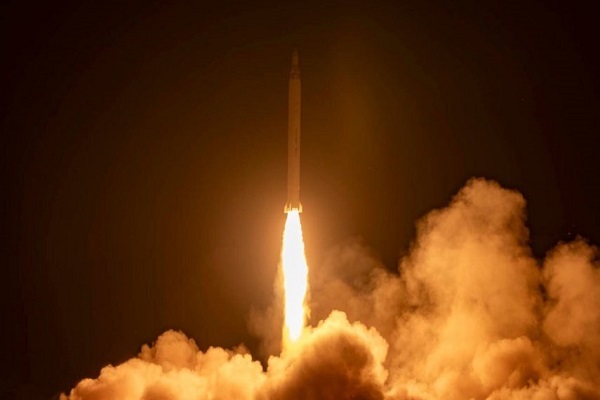Israel's vital facilities are under the range of Iran's missiles
TEHRAN (Defapress) – Israel's small territory would be a great target for Iran's hypersonic missiles if the Zionist regime commits any hostile action against Iran. According to the words of the Chief of the General Staff of the Armed Forces, Major General Bagheri, Iran is fully prepared to respond to the Zionist regime, harder than the True Promise 2 operation. During the True Promise 2 operation, Iran proved that it could target directly and exactly the locations it wanted.

As the Prime Minister of the Zionist regime's speech, they are planning to target Iran's oil and gas stations, besides the nuclear stations. As the Iranian officials warned before, Iran is a big country, but the occupied regime, with this small amount of land, makes it easier for Iran to target their infrastructure and destroy all of them in the blink of an eye. In the following, there is a list of infrastructures that can be targeted by Iran.
The Zionist regime's gas fields
The Zionist regime has four main gas fields, which mainly meet its needs from the three fields of Karish, Tamar, and Leviathan. The total annual gas production of this regime is 23.5 billion cubic meters, of which, on average, 11 billion cubic meters are exported per year. The Leviathan field, as the largest source of natural gas in this fake regime, produces 12 billion cubic meters of gas annually, which provides about 51% of Israel's gas needs. 70% of Israel's electricity production is also dependent on this field. Therefore, targeting it can cause serious disruptions in electricity supply and increase costs for settlers and industries.
The Tamar gas field, with an annual production of 10 billion cubic meters, is Israel's second-largest gas source and is mostly used to meet their domestic needs. Experts have estimated that if this field is hit, will cost nearly 1.5 billion dollars.
Karish gas field, with an average annual production of 6.5 billion cubic meters, is mainly used for export to Egypt and Jordan. The average annual income of the Zionist regime from gas exports is 4 billion dollars. In other words, targeting this field will mean a loss of income between 3 and 4 billion dollars along with its reconstruction costs.
The Israel's oil and refinery bases
Israel has limited oil resources and considering that 40% of its energy portfolio is dependent on oil, it mainly meets its needs through imports. There are only two oil fields in that region and both together produce less than 40,000 barrels per day. Haletz oil field which is located near Eshkol port and has a daily production capacity of 25,000 barrels, is the largest oil field of this regime. The Meged oil field also produces 10,000 barrels per day. In general, Israel consumes nearly 300,000 barrels of oil per day, of which more than 250,000 barrels are imported and a small amount is provided by domestic production.
Haifa and Ashdod refineries, as two important refineries in Israel, process imported oil and domestic production. The capacity of the Haifa refinery is about 200,000 barrels per day, and the cost of its reconstruction in case of an Iranian attack is estimated at more than 2 billion dollars.
Ashdod refinery is another refinery of this regime, which has a capacity of 100,000 barrels and the cost of its reconstruction is estimated at 1 billion dollars. The loss due to the stoppage of production will be about 210 million dollars for one month, considering the similar conditions of the Haifa refinery. In addition, damage to refineries can lead to an increase in the price of fuel in the market, which can affect the economic costs of the entire regime and cause serious problems in supplying energy to industries that depend on fuel.
The Zionist regime's Power Plants
Power plants are also other key energy centers of the Zionist regime. Hagit Power Plant is the largest power plant in Israel, which produces 1,800 megawatts of electricity daily. According to estimates, the possible damage to this power plant is estimated at one billion dollars. In addition, widespread blackout due to the capacity of this power plant is another consequence of the attack on it.
Orot Rabin power plant is another big source of power supply for the Zionist regime, which has a daily production capacity of 1,500 megawatts. Ashdod Power Plant is the third power plant in Israel, which contributes to the country's electricity supply with a production capacity of 1,200 megawatts per day. The Rutenberg Power Plant with a production capacity of 1000 megawatts, the Gezer Power Plant with a capacity of 600 megawatts, and the Ramet Hovav Power Plant with a capacity of 800 megawatts are other important power plants of the Zionist regime.
Targeting any of these power plants, especially the Power Plants that supply a significant part of this regime's electricity, in addition to the high costs of reconstruction, will cause widespread shutdowns, increase the cost of energy supply, and public dissatisfaction.
Based on the mentioned power stations, just hundreds of hypersonic missiles are enough to delete these bases from the Zionist regime map and cause great damage to them. As Iran's foreign minister, Abbas Araghchi said, the Zionist regime can test our will once again to see the consequences.
